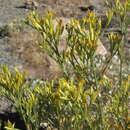Ericameria nauseosa is widespread, often abundant, and complex. This treatment is based largely on that by L. C. Anderson (1986b). Uncertainty about the specimen used by Pursh to establish
E. nauseosa (as
Chrysocoma nauseosa) is a possible source of confusion concerning the application of that name (which is in current use) and of the name
Chrysothamnus speciosus Nuttall (J. L. Reveal et al. 1999). Anderson divided the species into two informal groups, the "green forms" and the "gray forms." These two groups were formalized as subspp.
nauseosa and
consimilis by G. L. Nesom and G. I. Baird (1993), each containing varieties.
Ericameria nauseosa is reported to hybridize with other species in the genus, and hybrid and formula names have been applied to them. Their synonymies were more fully summarized by Nesom and Baird.
Ericameria ×bolanderi (A. Gray) G. L. Nesom & G. I. Baird, based on Linosyris bolanderi A. Gray is the hybrid between E. discoidea and E. nauseosa (L. C. Anderson and J. L. Reveal 1966).
Ericameria ×uintahensis (L. C. Anderson) G. L. Nesom & G. I. Baird, "Uinta rubber rabbitbrush," based on Chrysothamnus nauseosus subsp. uintahensis L. C. Anderson, is the hybrid between E. nauseosa and E. parryi (L. C. Anderson 1984).
Ericameria ×viscosa (D. D. Keck) G. L. Nesom & G. I. Baird, based on Chrysothamnus nauseosus subsp. viscosus D. D. Keck, is the hybrid between E. cuneata and E. nauseosa (L. C. Anderson 1986b).

